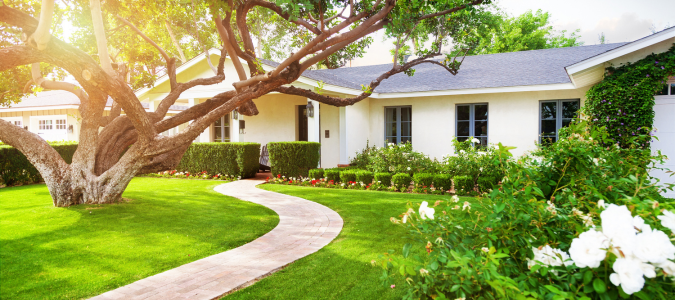Trees are worthwhile investments, bringing your property to life and boosting curb appeal. But if you want them to thrive and keep looking their best, you have to give them the TLC they deserve. That includes fertilizing them. Fertilizing trees requires technical know-how because different trees have unique requirements. It helps to know what fertilizer to use, how much to apply and how often.
If you’re unsure of how to fertilize a tree, here’s an in-depth guide to help you. However, it’s better to get tree care specialists to assist you with tree maintenance for the best results. They will identify the trees on your property and fertilize them according to their needs.
How to Fertilize a Tree: Fertilizer Types, Correct Amount and Application
There’s no need to worry if the soil on your property is short on nutrients. Fertilizers can compensate for that, providing the necessary nutrients for trees to flourish, flower and bear fruits. However, that doesn’t mean just dumping fertilizer on the soil and hoping for the best. Fertilizer usage should be intentional and have a clear objective.
Here are some things to consider when fertilizing your trees.
Determine the Need for Fertilizer
The first question to ask is if your trees need fertilizer. Mature trees planted in ideal soil conditions have little to no need for fertilizer. Only fertilize your trees for these reasons:
- A plant tissue analysis or soil test shows a nutrient deficiency.
- You want to stimulate growth in young, established trees.
- You want to maintain the growth of mature trees during seasons when they don’t have leaves. That means there’s little to no organic matter to provide the soil with nutrients.
- You want to boost the fruiting or flowering of your nut and fruit-producing trees. Fertilizer replenishes the nutrients you remove when you harvest nuts and fruits.
You can also use fertilizer to help out struggling trees. But before doing so, rule out other possible reasons for their poor growth. Unusually light green leaves, low shoot or twig growth and reduced flowering or fruiting can have various causes other than nutrient deficiency. For example, droughts, pests and excess water can all damage tree roots and hamper water absorption. Using fertilizer won’t solve these problems.
Select the Correct Fertilizer
Selecting the correct fertilizer for your trees can be overwhelming, given the many kinds available. A soil test can help you choose the ideal one.
Fertilizers have a grade indicated by three numbers, which you can find on their product label. The three numbers represent the weight and ratio of nitrogen, phosphorus and potassium. Arborists can help you determine the correct fertilizer based on your soil test results.
Here are the three types of fertilizers to choose from.
Complete Granular Fertilizer
This fertilizer contains three essential plant nutrients: nitrogen, phosphorus and potassium. Complete fertilizers used for trees usually have a 3:1:1 ratio. Select a grade that matches your soil and trees’ needs.
Slow-Release Fertilizer (SRF)
SRFs provide trees with a steady amount of nitrogen and other nutrients for an extended period. They can deliver a supply for up to four months, even during inclement weather. While they’re more expensive than fast-release fertilizers, they offer many benefits, like low toxicity, reduced burning risk and a healthier root system.
Organic Fertilizers
You can use organic fertilizers as an alternative to chemical ones. You can create your own by collecting shredded leaves and running them over with a lawnmower. That creates mulch, which will provide a slow release of nutrients for your trees. You can add a layer of compost, but limit it to one inch.
Measure Root Zone Size to Determine Correct Fertilizer Amount
Tree roots spread out wide, growing at least double the distance from the trunk as branches do. You can calculate the root radius by measuring the length from the trunk to the tip of the longest branch. You can then get the root zone size in square feet using this formula: root radius x root radius x 3.14. The general guideline is to apply a pound of nitrogen for every 1,000 square feet annually. One pound of nitrogen for every 1,000 square feet, divided by the percentage of nitrogen in decimals, will tell you the pounds of material you will need for every 1,000 square feet.
Apply Fertilizer Correctly
Before you start scattering fertilizer around your trees, use a proper application technique to be the most effective. Start by marking the perimeter of the root zone with flour or a garden hose. Next, create a circle three to four feet from the trunk. Spread the fertilizer between the two circles, avoiding the trunk. If your trees are on the lawn, apply fertilizer when the grass is dry.
Fertilizing trees involves complicated steps. Figuring out what fertilizer to use and calculating the correct amount of fertilizer can all be overwhelming. If you don’t want the additional stress, let tree care specialists help. They will provide optimal care for your trees, helping them thrive all year round.
When Should You Fertilize a Tree?
Aside from choosing the correct fertilizer and using a proper application technique, timing is another factor to consider. So, when should you fertilize a tree? The best time is between spring and early summer and late summer to early fall. These periods have ideal weather conditions and coincide with trees’ nutrient demand. In addition, tree roots actively grow during the late summer to early fall window.
Instead of applying the entire fertilizer amount in one go, split it into multiple batches. Supplying your trees with more manageable doses of nutrients ensures proper absorption and reduces wastage. If your trees are planted on sandy soil, which is more prone to leakage than other types, smaller batches of fertilizer will help reduce losses.
Fertilizing trees requires the right timing. In reality, homeowners are busy and don’t always have the time to fertilize during the recommended windows. If you have a lot on your plate, leave the fertilizing to tree care specialists. They will create the optimum fertilization schedule for your trees and ensure they receive the right amount of nutrients during the ideal times. They can also help with other tree care, like knowing how far tree branches should be from a house.
Should You Fertilize a Struggling Tree?
Even if you invest time and money into caring for your trees, some might not thrive. Should you still fertilize struggling trees, or are they not worth the effort? Trees exhibiting poor growth aren’t hopeless, and you can nourish them back to health with the help of fertilizer. One application method you can try for your struggling trees is deep-root fertilization.
With a high-pressure tool, you can inject essential nutrients and organic matter into the soil surrounding the tree roots. The fertilizer penetrates around five inches into the soil where the feeder roots are. This treatment is the most effective when you inject fertilizer in a grid pattern under the tree canopy. That ensures that the entire root zone is covered.
You’ll need the help of a tree care specialist to perform deep-root fertilization on your struggling trees. Compared to spreading fertilizer on top of soil, this treatment delivers longer-lasting effects and allows better nutrient absorption. Here are some signs that your trees are struggling and could use extra care and attention.
Discolored or Dropping Leaves
If the leaves on your trees are discolored or falling prematurely, that could indicate a nutrient deficiency. That’s something fertilizer can address. However, diseases and pests are other possible culprits. Unfortunately, fertilizer won’t do much to solve these problems. Identify the real cause to determine the appropriate solution.
Stunted Growth
Do your trees look more like shrubs instead of the majestic canopies you want them to be? Stunted growth could mean a lack of nutrients, sunlight or water. Fertilizer and other measures can help ease your trees’ stress and encourage them to grow.
Dead Branches
Another clue for struggling trees is if their branches are dead or decaying. Leaving this issue unaddressed will eventually attract pests to the dead branches. It can also cause accidents if the branches fall off. Cut off the dead branches to protect the other parts of the tree. You can also explore your fertilizer options to improve your trees’ health.
Regularly inspect your trees and check for signs of stress. Don’t give up on them just yet if they’re not looking their best. The correct fertilizer type and application method can help bring them back to life. Contact a tree care specialist to assess your trees and determine the best treatment method.
Struggling to Keep Your Trees in Good Shape? Let the Pros Help
Sad trees are not nice to look at on your property. If you’ve tried everything to help them flourish to no avail, it’s time to let tree care specialists take over. They can provide customized care according to your trees’ requirements. If there’s a nutrient deficiency, they know which fertilizer and application method to use to get your trees to thrive.
ABC Can Keep Your Trees Healthy
Taking care of your trees can take a lot of work. If you would rather spend your weekend enjoying your yard, contact ABC Home & Commercial Services. Our tree care team can make sure that your trees are healthy and get the care they deserve. We can even help you with other tree care tasks, like tree pruning and trimming.



